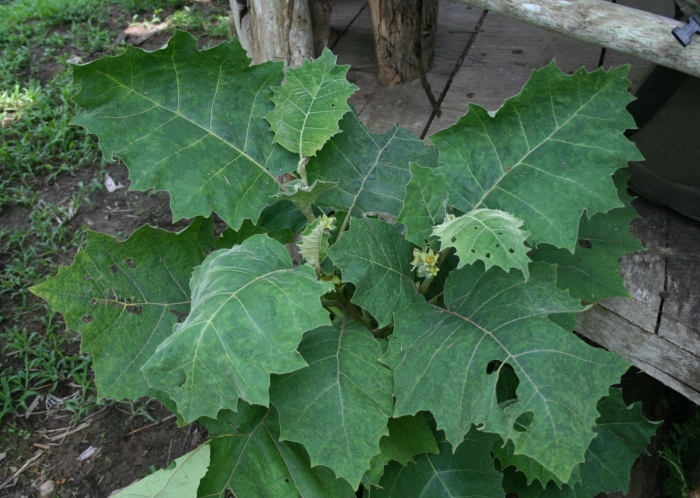Cocona
(Solanum sessiliflorum)
Cocona (Solanum sessiliflorum)
/
/

Franz Xaver
CC BY-SA 3.0
Image By:
Franz Xaver
Recorded By:
Copyright:
CC BY-SA 3.0
Copyright Notice:
Photo by: Franz Xaver | License Type: CC BY-SA 3.0 | License URL: https://creativecommons.org/licenses/by/2.0 | Uploader: Franz Xaver | Publisher: Wikimedia Commons |



































Estimated Native Range
Summary
Solanum sessiliflorum, commonly known as Cocona, is an evergreen or semi-deciduous shrub native to the humid tropical forests and riverine habitats of the Northwestern Amazon Basin. It typically grows to a height of 3-10 feet (1-3 meters) with a similar spread. The cocona plant has sturdy branches and large, hairy, serrate leaves that can add a lush, tropical feel to a garden. Its flowers are showy, resembling those of a potato plant, with light green petals and prominent yellow stamens, blooming intermittently throughout the year. The fruit is an edible berry that varies in color from red to orange or yellow and is notable for its unique flavor, often used in local cuisines.
Cocona is valued for its ornamental foliage, attractive flowers, and edible fruit, making it a multifunctional plant in cultivation. It is suitable for tropical-themed gardens, as a potted indoor plant in temperate climates, and for culinary use. The plant requires high humidity and protection from frost, thriving in full sun to partial shade. It prefers consistently moist, well-draining soil. While it can tolerate short periods of cool weather, it is not frost-hardy and should be moved indoors or protected during cold spells. Cocona can be susceptible to pests such as spider mites, aphids, and nematodes, especially when grown indoors where air may be dry. Regular monitoring and maintaining appropriate humidity levels can help prevent infestations.CC BY-SA 4.0
Cocona is valued for its ornamental foliage, attractive flowers, and edible fruit, making it a multifunctional plant in cultivation. It is suitable for tropical-themed gardens, as a potted indoor plant in temperate climates, and for culinary use. The plant requires high humidity and protection from frost, thriving in full sun to partial shade. It prefers consistently moist, well-draining soil. While it can tolerate short periods of cool weather, it is not frost-hardy and should be moved indoors or protected during cold spells. Cocona can be susceptible to pests such as spider mites, aphids, and nematodes, especially when grown indoors where air may be dry. Regular monitoring and maintaining appropriate humidity levels can help prevent infestations.CC BY-SA 4.0
Plant Description
- Plant Type: Shrub
- Height: 3-6 feet
- Width: 2-4 feet
- Growth Rate: Moderate
- Flower Color: N/A
- Flowering Season: Spring, Summer, Fall
- Leaf Retention: Evergreen
Growth Requirements
- Sun: Full Sun
- Water: Medium
- Drainage: Medium, Fast
Common Uses
Bee Garden, Bird Garden, Butterfly Garden, Deer Resistant, Drought Tolerant, Fragrant, Hummingbird Garden, Rabbit Resistant
Natural Habitat
Humid tropical forests and riverine habitats of the Northwestern Amazon Basin
Other Names
Common Names: Orinoco-Apple, Peach-Tomato, Topiro, Tomate Chauve Souris, Cubiu
Scientific Names: , Solanum sessiliflorum, Solanum topiro, Solanum sessiliflorum var. sessiliflorum, Solanum alibile, Solanum arecunarum,
GBIF Accepted Name: Solanum sessiliflorum Dunal